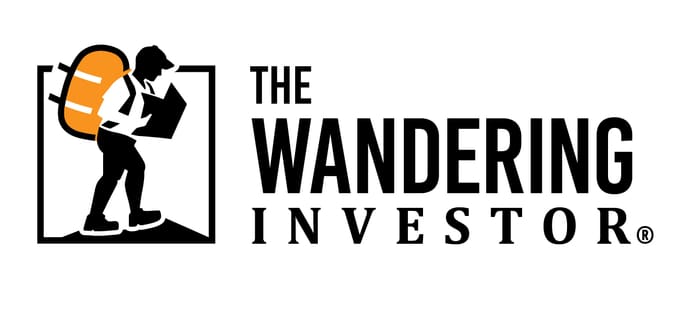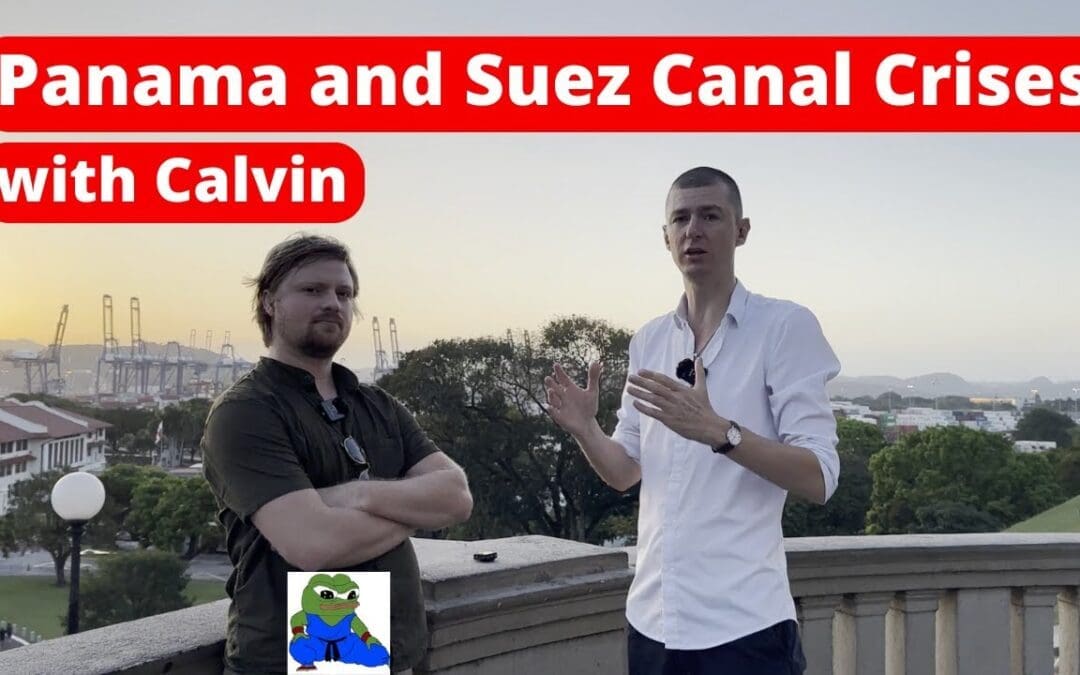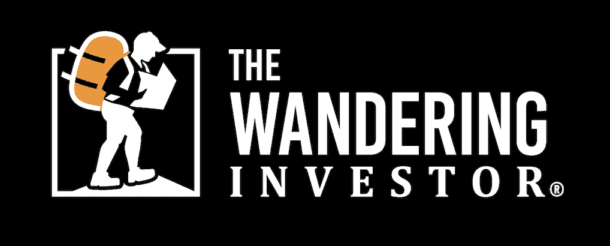Few people are discussing this, but for the first time ever both the Panama Canal and the Suez Canal are experiencing reduced throughput by approximately 50%.
The implications of this are massive. Already, shipping rates have ballooned, which means many shipping companies will probably have record profits, but there are also other impacts on the world economy.
I am currently in Panama, and met up with Calvin to discuss this matter.
Calvin runs a very interesting subscription service on investing in shipping, commodities, industrials, etc. which includes a model portfolio.
It’s called Marhelm, and if you use the coupon code WANDER you get 20% off lifetime.
He’s the one who convinced me to make a highly profitable investment in Ecopetrol back in late 2022.
To a World of Opportunities,
The Wandering Investor.
If you want to read more such articles on other real estate markets in the world, go to the bottom of my International Real Estate Services page.
Subscribe to the PRIVATE LIST below to not miss out on future investment posts, and follow me on Instagram, X, LinkedIn, Telegram, Youtube, Facebook, and Rumble.
My favourite brokerage to invest in international stocks is IB. To find out more about this low-fee option with access to plenty of markets, click here.
If you want to discuss your internationalization and diversification plans, book a consulting session or send me an email.
Transcript of “Impact of Suez Canal and Panama Canal Crises – with Calvin”
LADISLAS MAURICE: Hello, everyone. Ladislas Maurice from thewanderinginvestor.com. Today, I am right in front of the Panama Canal here in Panama City, together with Calvin. Calvin, how are you?
CALVIN: Good. Thanks for having me.
LADISLAS MAURICE: Calvin runs a research service on shipping. And we’ll be discussing some of the latest developments, which are really huge, that few people are discussing, and that are going to have a very big impact on the economy if it continues this way. Can you tell us about the developments here at the Panama Canal and also at the Suez Canal?
Throughput down 50% at the Panama Canal
CALVIN: Right. The Panama Canal was completed in the early 20th century, the Suez Canal was completed mid-19th century. And we’ve essentially never had a situation where both of these canals have had their throughput greatly affected at the same time for a long time. That’s very big for shipping, it’s very big for a lot of commodity shipping, retail shipping, it’s inflationary, it causes congestion delays, supply chain issues, so it’s definitely anybody who follows economics or markets this should be right at the center of their focus.
LADISLAS MAURICE: Throughput is down by how much here at the Panama Canal?
CALVIN: It’s about 50%.
LADISLAS MAURICE: And why?
CALVIN: In Panama, the issue is that the water level of Gatun Lake, it’s a freshwater lake, and it’s what they use to regulate the locks. Essentially, Panama is an isthmus and the Atlantic and Pacific sides, they’re not the same elevation. And you have to essentially change the water level to get a ship between the two sides. In order to do that, the ship goes into the lock, the canal pumps the water in, and that either raises or lowers the ship down to or up to the level that it needs to be to pass through. And in the middle of these two saltwater sources, you have a freshwater source. And you can’t contaminate the freshwater with the saltwater, so you can only use freshwater to regulate the water levels.
LADISLAS MAURICE: So is this just a one-off or is it recurring? Because it wasn’t like this before.
CALVIN: In 2016, they did an expansion of the canal so that they could allow bigger ships to go through. And so there have been droughts before in Panama’s history. But right now, the seasonal water levels in the lake are, by far, the most extreme low that they’ve ever been. I think that it’s probably a mix of factors, the canal expansion and sort of the seasonal weather patterns. El Nino, this is typically the dry part of the year, it’s going to get drier over the next couple of months. But this has been something that’s been sort of getting worse with time.
LADISLAS MAURICE: So it’s partially structural and partially seasonal. What’s the alternative for shippers?
CALVIN: Well, the alternative to going through the Panama Canal is to go around South America. And obviously, that’s a lot longer.
LADISLAS MAURICE: How many days extra?
CALVIN: Different ships travel at different speeds. But, let’s say, minimum, it’s anywhere from a few weeks to a month.
LADISLAS MAURICE: Wow. Inflationary.
CALVIN: Definitely inflationary. The other aspect is, I don’t think it’s really affected Panama’s budget so much, because they’ve essentially raised rates and they’ve also implemented an auction system so that people can bid to get a slot to go through. But yeah, reducing that throughput has had huge effects on shippers, energy traders, commodity traders. I had dinner with an energy trader in Spain, he’s the guy that books the ships. I asked him, “What would make the biggest impact on your business?” And he said, knowing when the Panama Canal auctions will be and how much they will be. Because you just can’t really plan if you have some huge costs and huge time delay that you don’t really know what it’s going to be until it comes.
Throughput down 50% at the Suez Canal
LADISLAS MAURICE: So the situation here is quite bad. But what about the Suez Canal?
CALVIN: The Suez Canal, the issue is the Houthis in Yemen have essentially said that they don’t want to let any ship with ties to Israel go through the Red Sea. The Red Sea is the southern entrance to the Suez Canal. And, obviously, shipping is global. If you think about where a ship would call port, who are the shareholders of shipping companies, theoretically, you could make a connection to Israel with just about any ship. The Houthis have been firing missiles. They’re supported by Iran with a lot of technical services and weapons. They do represent a very credible threat. They’re not just goat herders, they do have advanced ballistics capabilities. They were the first group in the world to hit a moving ship with a ballistic missile.
LADISLAS MAURICE: That’s impressive.
CALVIN: The way that a ballistic missile works is, essentially, you fire something from the ground, and then it comes back down with gravity. It’s not so much a guided missile, it’s not a cruise missile. It’s pretty complicated to hit a moving target with ballistic missiles. Ballistics are typically used to hit large stationary things like cities.
LADISLAS MAURICE: And the throughput is down by how much there?
CALVIN: The Suez throughput, let’s say, it’s also down, on average, about half. The container sector has been by far the most affected. The container sector has had its throughput reduced. It varies day to day, it’s been as much as 90%. Let’s say it’s 70% on average now.
LADISLAS MAURICE: Yeah. So on a separate note, this is very bearish for Egypt, which has a very deep current account deficit issue. So suddenly, all that income being gone is absolutely not bullish Egypt. What’s the alternative route, then?
CALVIN: Well, the alternative route is around Africa.
LADISLAS MAURICE: And how many extra weeks is that?
CALVIN: Anywhere from a few weeks to a month, depending on the speed of the ship.
LADISLAS MAURICE: [laughs]
CALVIN: Same as the issue here.
LADISLAS MAURICE: And so we’ve had the Suez Canal being closed down for a few years in the past.
CALVIN: Right.
LADISLAS MAURICE: What was the impact on the whole shipping industry back then?
CALVIN: Well, the ’67 to ’75 closure, that was sort of when the age of the supertanker started. And that age started because they needed to find a new way to get oil out of the Middle East, because they couldn’t really rely on the Suez Canal. They started building these very large crude carriers, which were basically gigantic multiple football field size ships for carrying crude oil. Between 1970 and 1975, the size of that fleet increased by about 15x.
Impact on inflation
LADISLAS MAURICE: Wow. Okay. Looking at the current situation, I see inflation from two sides. One is with the increase in shipping rates, because it takes longer, and, two, all the supply chain disruptions. So if a spare part was to take three weeks before, now it might take six weeks.
CALVIN: Yeah, absolutely. As you said, one, you get backed up on shipments. If you have an industrial operation and you really need some components, those components are on a ship, they’re back a couple of weeks, then now your customers are down a couple of weeks, their customers are down a couple of weeks. That’s sort of the same thing that we saw after COVID.
It’s been interesting, also, watching some of the skepticism from people on whether or not this would have global impacts. And I’ve said from the very beginning, absolutely it will have global impacts. Both of these canals having their throughput impacted to this level is historically unprecedented. And if the situation persists, you’re going to see freight rates much higher pretty much across the board. It’s going to cause more congestion, it’s going to cause schedule slippage. And it’s not just like one little area is affected, shipping is global. You mess things up considerably in one key choke point, you’ve affected the whole planet.
Impact on reshoring
LADISLAS MAURICE: So bullish reshoring?
CALVIN: Maybe. The thing about reshoring is you need to have the industrial capacity in place to do it. It’s not an overnight solution. It takes years to build factories, and highways, and railroads, and pipelines, right? So it’s not an overnight solution. And the steel production capacity, for instance, or the cement production capacity in the United States is also limited. There’s a lot of components that we just simply don’t produce here anymore. A lot of electronics that we don’t make here, right? So you can’t go from a very globalized world to a somewhat decentralized world in a short time period. And even if you do move towards that, globalization has been a very deflationary trend. We’re talking about lower and lower cost, faster and faster delivery schedules, very optimized shipment processes. And that has really been enabled sort of by the Pax Americana, American global dominance and protecting shipping lanes. But it seems like we’re not really able to do that anymore.
Now if you need a factory in US, or Mexico, or Brazil that does the same things that a factory in China was doing, making those new factories and making those new products, all these redundancies, it might be bad for the producers of those products. They might see lower earnings in China because they don’t have as many customers, but on a global basis, you’re talking about the need for a lot more raw materials in those local levels. I would say, long term, reshoring is probably structurally bearish large ships. But again, it’s something that’s going to take a very long time to happen.
LADISLAS MAURICE: Interesting. So essentially, your research service takes this sort of thinking and research and translate itself into a model portfolio. Correct?
CALVIN: Right. We have a model portfolio, we post trade ideas, we post weekly updates. We sort of follow the sector fundamentals, we follow the companies, we follow the commodities, we follow the big industrial companies. Shipping is sort of most of human trade revolves around stuff moving around on ships. It’s the most efficient form of transport. I think that if you want to really get an edge in the markets, you can’t do better than studying shipping.
LADISLAS MAURICE: Interesting. Great. If you’re interested, there is an affiliate link below with a 20% discount for his newsletter (use coupon code WANDER). There is both an annual plan and a monthly plan. So if you just want to try it for a month, low risk, you can try that as well. Great. Calvin, thank you.
CALVIN: Thank you very much.
LADISLAS MAURICE: Always a pleasure.
CALVIN: Yeah.


